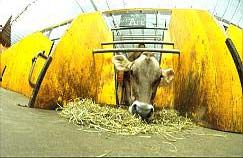In a feeding trial with dairy cows, the feed value (especially the protein effect) of these feeds is tested in comparison to the protein sources soybean meal and rapeseed cake.
When alcohol is produced from grain, so-called stillage is produced as a by-product. Starch is converted into sugar and yeast is used to ferment alcohol. This enriches the remaining nutrients in the grain. The multiplication of yeast cells also leads to the formation of new proteins (MENKE & HUSS 1987).
Table 1 shows the nutrient contents of some types of grain, the stillages produced from them and the protein feedstuffs soybean meal and rapeseed cake for comparison (DLG 1997). Through alcohol production, the starch content of the grain raw material decreases from 60 - 70% to less than 10% and all other nutrients increase (crude protein from 12 to 31%, crude fat from 3 to 7%, crude fiber from 3.6 to 10.9%). . The loss of starch is associated with a decrease in digestibility (from 87 to 73%) and energy concentration (from 8.4 to 7.1 MJ NEL). The protein and energy content of typical protein feeds such as soybean meal and rapeseed cake is higher.
The analyzes of "Starprot wheat" and "Starprot maize" (carried out in the Rosenau feed laboratory of the Lower Austrian State Chamber of Agriculture and the LKS feed laboratory in Lichtenwalde, Saxony) show extensive agreement with the values in the DLG table (DLG 1997). However, according to analysis by the LKS feed laboratory in Lichtenwalde, a significantly higher protein resistance (UDP) is assumed. In a feeding trial with dairy cows, the feed value (especially the protein effect) of these feeds is tested in comparison to the protein sources soybean meal and rapeseed cake.
Table 1: Nutrient content of the concentrated feed components (in DM)
(DLG 1997)
|
XP |
XL |
XF |
XX |
XA |
XS |
dom |
M.E |
NEL |
UDP |
nXP |
RNB |
|
|
G |
G |
G |
G |
G |
G |
% |
MJ |
MJ |
% |
G |
G |
|
|
barley |
119 |
23 |
52 |
779 |
27 |
604 |
87 |
12,93 |
8,16 |
25 |
165 |
-7 |
|
Wheat |
138 |
20 |
29 |
794 |
19 |
662 |
89 |
13,37 |
8,51 |
20 |
172 |
-5 |
|
corn |
106 |
45 |
26 |
806 |
17 |
694 |
86 |
13,29 |
8,39 |
50 |
164 |
-9 |
|
Barley stillage |
283 |
68 |
126 |
467 |
56 |
50 |
67 |
10,94 |
6,49 |
40 |
206 |
+12 |
|
Wheat stillage |
362 |
67 |
97 |
416 |
58 |
33 |
- |
- |
- |
- |
- |
- |
|
Starprot wheat1) |
360 |
30 |
70 |
490 |
50 |
20 |
80,6 |
12,10 |
7,40 |
60 |
317 |
+6,8 |
|
Corn stillage |
297 |
82 |
104 |
466 |
51 |
92 |
79 |
12,68 |
7,75 |
50 |
242 |
+9 |
|
Starprot corn1) |
290 |
130 |
67 |
461 |
52 |
58 |
89,2 |
13,60 |
8,40 |
70 |
306 |
-2,6 |
|
Soya extra meal 44 |
510 |
15 |
67 |
341 |
67 |
69 |
91 |
13,75 |
8,63 |
35 |
308 |
+32 |
|
Rapeseed cake |
370 |
101 |
128 |
326 |
75 |
0 |
80 |
13,06 |
7,99 |
30 |
217 |
+25 |
1) Company details (STHG - STARREIN, Weitersfeld, Lower Austria)
Experimental procedure:
The experiment is carried out using the Latin square method with 15 animals (3 × 3) in 3 periods. A period lasts 4 weeks.
Feed ration:
The basic feed consists of 50% grass silage (2nd cut), 20% hay (1st cut) and 30% corn silage (TM basis). A possible milk yield from the basic feed is assumed to be 14 kg. For every kg of excess milk yield, 0.5 kg of concentrate is administered (FM basis).
The concentrated feed is made up of energy sources (90% barley, 10% wheat bran) and protein sources. The protein feeds pose the experimental question:
Rapeseed/soy: 60% rapeseed cake, 35% soy extraction meal, 5% vegetable fat (control group)
Starprot wheat: 90% Starprot wheat, 10% vegetable fat
Starprot corn: 100% Starprot corn
Rapeseed cake and vegetable shortening are used to compensate for the high fat content of Starprot corn. The mixture proportions of the experimental concentrates and their nutrient content are listed in Table 2. The concentrated feed should have the same content of nXP, NEL and crude fat (180 g nXP, 4.3% XL, 8.0 MJ NEL).
Table 2: Composition (% FM) and nutrient content of the experimental concentrates (in DM)
|
composition |
Rapeseed/soy |
Starprot wheat |
Starprot corn |
|
|
barley |
% |
72,0 |
74,3 |
74,7 |
|
Wheat bran |
% |
8,0 |
8,3 |
8,3 |
|
Rapeseed cake |
% |
12,0 |
- |
- |
|
Soy extraction meal 44 |
% |
7,0 |
- |
- |
|
Starprot wheat |
% |
- |
15,8 |
- |
|
Starprot corn |
% |
- |
- |
17,0 |
|
Vegetable fat |
% |
1,0 |
1,8 |
- |
|
Nutrient content |
||||
|
XP |
G |
179 |
158 |
151 |
|
XL |
G |
43 |
43 |
43 |
|
XF |
G |
68 |
61 |
61 |
|
XX |
G |
672 |
705 |
710 |
|
XA |
G |
38 |
33 |
34 |
|
NEL |
MJ |
8,07 |
8,00 |
8,01 |
|
nXP |
G |
181 |
181 |
180 |
|
UDP |
%XP |
28,2 |
37,5 |
39,6 |
|
RNB |
G |
-0,4 |
-3,5 |
-4,5 |
The animals receive 100 g of mineral mixture and 40 g of cattle salt every day. The basic feed is ad lib. offered (5 to 7% return weight).
Surveys:
Live mass: 1 time per week
Milk yield: Daily (amount and ingredients)
Feed intake: in the 4th experimental week of a period
BCS: 2 times per period
Feed analysis: collective sample per period (Weender analysis, structural substances, minerals and trace elements, cellulase)







